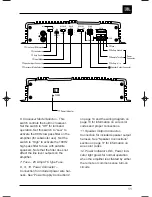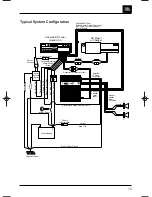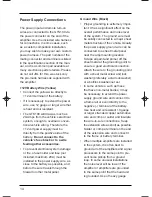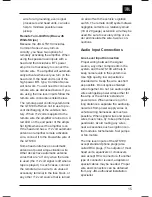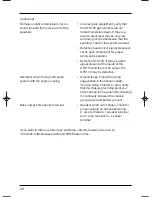
and 16 volts. Check that the power
wires are not reversed.
If the GTS100 is operated at very high
power levels in a high ambient tempera-
ture situation, the unit may not be able
to radiate all the heat generated by
such operation. If the temperature of
the amplifier reaches a level that could
cause damage, the thermal overload
protection circuit will turn the amplifier
off. It will turn the amp back on again
when it cools off. Repeated activation of
the protection circuits indicates that the
system is being improperly operated or
that the amplifier should be relocated to
an area that either has a lower ambient
temperature or that allows more air cir-
culation around the unit.
Fuse Replacement – If the fuse on the
GTS100 must be replaced, DO NOT
use a fuse rated for higher current lev-
els. The fuse size for the GTS100 is 20
amps. Exceeding the standard fuse size
or bypassing the fuse holder will void
the warranty and may cause serious
damage. It is extremely rare for this
fuse to blow. If it blows repeatedly, it is
most likely that the amplifier has an
internal problem that will need to be
repaired by an authorized service cen-
ter. The only external cause for this
fuse to blow is reversed polarity of the
power wire connections.
Solving Noise Problems
The power supply system of every vehi-
cle has some electrical “noise” that is
generated by the ignition system, the
alternator, the accessories, and their
wiring. High performance audio equip-
weather) before the amplifier will pro-
duce sound. This eliminates the chance
of annoying noises produced by the
radio or signal processors being ampli-
fied and passed to the speakers when
the system is first turned on.
Power Consumption – Operating the
GTS100 when the vehicle is not running
may discharge the battery. Under nor-
mal operating conditions, the units will
draw an average of 5 amps from the
battery. At high volumes, the amplifier
can draw as much as 20 amps for brief
bursts. After even a short period of
time, this current drain can discharge
the battery to the point that it will not
start the vehicle. Power consumption
under “no signal” conditions is less than
1 amp for the GTS100. Even this small
power usage can discharge a battery
over several hours time. When the
GTS100 is turned off, there is no cur-
rent drawn from the battery despite the
direct-to-battery power connection.
Overload Protection – The GTS100
incorporates elaborate protection cir-
cuitry to prevent damage to the ampli-
fier circuitry and ensure reliable opera-
tion. This circuitry will turn the amplifier
off in the event of overheating, a short
circuit on the speaker output wiring, or
improper power supply connections. If
the amplifier cycles on and off, or does
not work at all, a problem in installation
or an abnormal electrical condition is
indicated. Check speaker wiring for
short circuits or impedance loads signif-
icantly below 2 ohms, (4 ohms in
bridged mode). Check the power supply
voltage at the input of the amplifier to
be sure that it is normal, between 11
21
JBL 1394 Manual 7/17/98 11:49 AM Page 21





